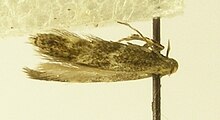| Elachista canapennella | |
|---|---|

| |

| |
|
Scientific classification
| |
| Domain: | Eukaryota |
| Kingdom: | Animalia |
| Phylum: | Arthropoda |
| Class: | Insecta |
| Order: | Lepidoptera |
| Family: | Elachistidae |
| Genus: | Elachista |
| Species: | E. canapennella
|
| Binomial name | |
| Elachista canapennella (
Hübner, 1813)
| |
| Synonyms | |
|
List
| |
Elachista canapennella is a moth of the family Elachistidae found in Europe.
Description
The wingspan is 8–10 millimetres (0.31–0.39 in). [1] The head is grey, face whitish. Forewings in male pale grey irrorated with black, in female blackish except on basal area; a somewhat oblique fascia before middle, a tornal spot, and triangular costal spot somewhat beyond it in male very indistinct, whitish, almost obsolete, in female broader, white, conspicuous. Hindwings are grey. The larva is pale yellowish-grey ; head pale brown. [2]
Adults are on wing from April to June and from July to September. There are two generations per year.
The larvae feed on creeping bent ( Agrostis stolonifera), false oat-grass ( Arrhenatherum elatius), Avenula pubescens, tufted hairgrass ( Deschampsia cespitosa), fescue ( Festuca species), creeping soft grass ( Holcus mollis) and meadow-grass ( Poa). They mine the leaves of their host. The pupation takes place outside the mine. [3]
Distribution
It is found from Fennoscandia and northern Russia to the Pyrenees, Italy and Romania and from Ireland to central Russia. [3]
References
- ^ "Elachista canapennella". UK Moths. Retrieved March 8, 2010.
-
^ Meyrick, E., 1895 A Handbook of British Lepidoptera MacMillan, London
pdf
 This article incorporates text from this source, which is in the
public domain. Keys and description
This article incorporates text from this source, which is in the
public domain. Keys and description
- ^ a b Ellis, W N. "Elachista canapennella (Hübner, 1813) little dwarf". Plant Parasites of Europe. Retrieved 26 March 2020.
External links
| Elachista canapennella | |
|---|---|

| |

| |
|
Scientific classification
| |
| Domain: | Eukaryota |
| Kingdom: | Animalia |
| Phylum: | Arthropoda |
| Class: | Insecta |
| Order: | Lepidoptera |
| Family: | Elachistidae |
| Genus: | Elachista |
| Species: | E. canapennella
|
| Binomial name | |
| Elachista canapennella (
Hübner, 1813)
| |
| Synonyms | |
|
List
| |
Elachista canapennella is a moth of the family Elachistidae found in Europe.
Description
The wingspan is 8–10 millimetres (0.31–0.39 in). [1] The head is grey, face whitish. Forewings in male pale grey irrorated with black, in female blackish except on basal area; a somewhat oblique fascia before middle, a tornal spot, and triangular costal spot somewhat beyond it in male very indistinct, whitish, almost obsolete, in female broader, white, conspicuous. Hindwings are grey. The larva is pale yellowish-grey ; head pale brown. [2]
Adults are on wing from April to June and from July to September. There are two generations per year.
The larvae feed on creeping bent ( Agrostis stolonifera), false oat-grass ( Arrhenatherum elatius), Avenula pubescens, tufted hairgrass ( Deschampsia cespitosa), fescue ( Festuca species), creeping soft grass ( Holcus mollis) and meadow-grass ( Poa). They mine the leaves of their host. The pupation takes place outside the mine. [3]
Distribution
It is found from Fennoscandia and northern Russia to the Pyrenees, Italy and Romania and from Ireland to central Russia. [3]
References
- ^ "Elachista canapennella". UK Moths. Retrieved March 8, 2010.
-
^ Meyrick, E., 1895 A Handbook of British Lepidoptera MacMillan, London
pdf
 This article incorporates text from this source, which is in the
public domain. Keys and description
This article incorporates text from this source, which is in the
public domain. Keys and description
- ^ a b Ellis, W N. "Elachista canapennella (Hübner, 1813) little dwarf". Plant Parasites of Europe. Retrieved 26 March 2020.
External links